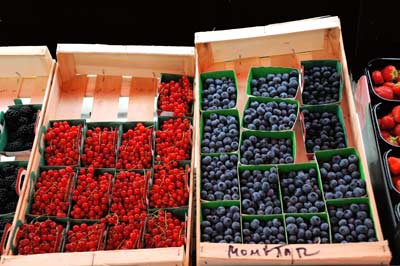Blue is either used to describe the degree of cooking of meat, indicating that it is very rare or as an abbreviation for blue cheese, that is cheese with a mould running through it.
Russule or charcoal burner, a mushroom that closely resembles other bitter, indedible ones.
Lake herring. A fish with iridescent skin found in the Great Lakes. It is an oily fish and is often smoked. It is sometimes sold as whitefish.
Sockeye salmon or red salmon, also known as king salmon, has a four year life-cycle which contributes to the meatiness of its flesh, which is dense and velvety and turns deep red before spawning. It is a fish of the northern Pacific. In Japan it is most often grilled. Elsewhere it is very often tinned.
A grey-green variety of squash, which can grow to the enormous size of around 60 cm long.

The blueberry belongs to the same family as the bilberry and is similarly small, round and dark bluish, indigo-black with smooth bloomy skin. The flesh is grey-blue and juicy. There are high-bush or low-bush varieties. They don’t have quite as much flavour as bilberries, and can benefit from a squeeze of lemon. They are generally used in pies or jams (US: jellies) or in blueberry muffins. The blueberry is a relative of the cranberry. Don't wash any soft fruit until it is about to be used or it is likely to rot. The American blueberry is larger than the northern European variety but tastes pretty much the same. The Northern high-bush blueberry is the most commonly seen blueberry growing, not surprisingly, on high bushes anything up to 4.5 meters (15 ft) high. The rabbit-eye or low-bush varieties are wild varieties producing smaller fruit. Translations to blueberry in Europe often actually mean bilberry (Vaccinium myrtillus) rather than blueberry (Vaccinium corymbosum) but it is sometimes difficult to tell.
A popular type of "muffin" or light sponge cake, filled with blueberries and often served for breakfast.